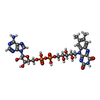+Search query
-Structure paper
| Title | A marine cryptochrome with an inverse photo-oligomerization mechanism. |
|---|---|
| Journal, issue, pages | Nat Commun, Vol. 14, Issue 1, Page 6918, Year 2023 |
| Publish date | Oct 30, 2023 |
 Authors Authors | Hong Ha Vu / Heide Behrmann / Maja Hanić / Gayathri Jeyasankar / Shruthi Krishnan / Dennis Dannecker / Constantin Hammer / Monika Gunkel / Ilia A Solov'yov / Eva Wolf / Elmar Behrmann /  |
| PubMed Abstract | Cryptochromes (CRYs) are a structurally conserved but functionally diverse family of proteins that can confer unique sensory properties to organisms. In the marine bristle worm Platynereis dumerilii, ...Cryptochromes (CRYs) are a structurally conserved but functionally diverse family of proteins that can confer unique sensory properties to organisms. In the marine bristle worm Platynereis dumerilii, its light receptive cryptochrome L-CRY (PdLCry) allows the animal to discriminate between sunlight and moonlight, an important requirement for synchronizing its lunar cycle-dependent mass spawning. Using cryo-electron microscopy, we show that in the dark, PdLCry adopts a dimer arrangement observed neither in plant nor insect CRYs. Intense illumination disassembles the dimer into monomers. Structural and functional data suggest a mechanistic coupling between the light-sensing flavin adenine dinucleotide chromophore, the dimer interface, and the C-terminal tail helix, with a likely involvement of the phosphate binding loop. Taken together, our work establishes PdLCry as a CRY protein with inverse photo-oligomerization with respect to plant CRYs, and provides molecular insights into how this protein might help discriminating the different light intensities associated with sunlight and moonlight. |
 External links External links |  Nat Commun / Nat Commun /  PubMed:37903809 / PubMed:37903809 /  PubMed Central PubMed Central |
| Methods | EM (single particle) |
| Resolution | 2.57 - 8.0 Å |
| Structure data | EMDB-17429, PDB-8p4x:  EMDB-17533: FAD_AQ bound blue-light state structure of PdLCry |
| Chemicals |  ChemComp-FAD:  ChemComp-MG:  ChemComp-HOH: |
| Source |
|
 Keywords Keywords |  FLAVOPROTEIN / light-sensitive / circalunar clock FLAVOPROTEIN / light-sensitive / circalunar clock |
 Movie
Movie Controller
Controller Structure viewers
Structure viewers About Yorodumi Papers
About Yorodumi Papers






